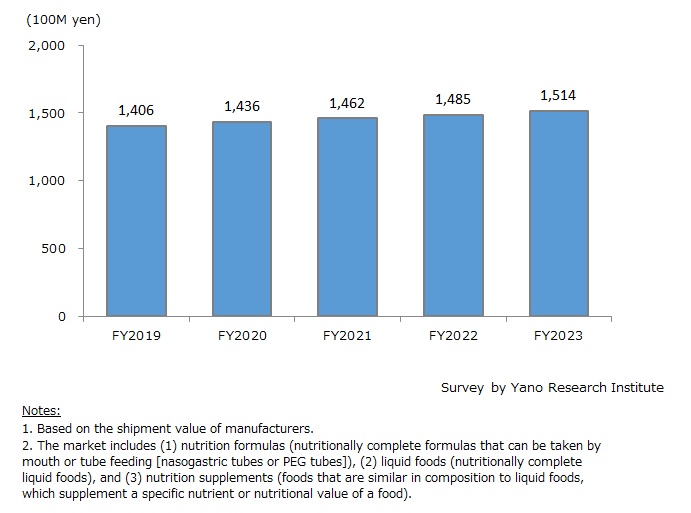No.3721
Nutrition Formulas, Liquid Foods, and Nutritional Supplements in Japan: Key Research Findings 2024
Market Size of Nutrition Formulas, Liquid Foods, and Nutrition Supplements for FY2023 Grew Slightly to 151,400 Million Yen, 102.0% of Preceding Fiscal Year
Yano Research Institute (the President, Takashi Mizukoshi) conducted a survey on the domestic market of nutrition formulas, liquid foods, and nutrition supplements, and found out the trends by segment, the trends of market players, and future perspectives.


Market Overview
The market size of nutrition formulas, liquid foods, and nutrition supplements for FY2023 was estimated at 151,400 million yen, which was 102.0% of that of the preceding fiscal year. In detail, the market mix is composed of the nutrition formulas market, which grew to 39,000 million yen (103.8% on a year-on-year basis), the liquid foods market, which attained 82,200 million yen (100.5% on a same basis), and the nutrition supplements market, which generated 30,200 million yen (103.7% on a same basis).
Stable growth is observed for all three categories. Liquid foods are used primarily at hospitals and nursing homes for the elderly. Nutrition formulas are mainly used for homecare, for it is covered by National Medical Insurance. Nutrition supplements are similar in composition to liquid foods for seniors or patients, yet it specializes in supplementing specific nutrient or nutritional value, utilized as a supplementary food (snacks and desserts) to improve the nutrition of hospital inpatients and hospitals and the elderly at nursing homes.
Noteworthy Topics
Liquid Foods Address to Needs for Decreasing Workloads of Medical Professionals
Hospitals and nursing facilities are increasingly using liquid foods in feeding bags. By eliminating the need to pour a prescribed amount of liquid food into the bag (required when using liquid foods in paper cartons) these ready-to-use products reduce both preparation time and labor. They also lower the risk of contamination during preparation.
In addition, defecation management is required to reduce workloads of medical fields. From this standpoint, fiber-enriched liquid foods are gaining popularity, as they are believed to improve intestinal health and prevent diarrhea. Manufacturers are increasingly launching new products with a focus on the type of dietary fiber used, as well as updating existing products to be higher-value items, such as those fortified with fermentable dietary fiber.
Future Outlook
Nutritional supplements covered by health insurance will continue to be primarily used in homecare. The functionality of these supplements has expanded in recent years. For example, products tailored to the nutritional needs of patients with low metabolism have been approved for production and sale. Driven by ongoing NHI price revisions, the nutritional supplements market is expected to experience modest growth.
Amid the aging population, manufacturers of liquid foods are introducing oligomeric formulas, the type of liquid foods believed to excel in absorption efficiency. The range of liquid foods for patients in the acute phase is expected to expand in the future.
The demand for nutritional supplements containing medium-chain triglycerides (MCTs) is expected to increase, especially among elderly individuals with reduced appetites. This growth is driven by rising awareness of the importance of nutritional management for seniors, both among the elderly needing homecare and their families. Health programs on TV and other media have played a significant role in promoting this awareness, further fueling market expansion.
Research Outline
2.Research Object: Manufacturers of nutrition formulas, liquid foods, and nutrition supplements
3.Research Methogology: Face-to-face interviews by our expert researchers (including online interviews), survey via telephone, and literature research
What are the Markets of Nutrition Formulas, Liquid Foods, and Nutrition Supplements?
“Nutrition formulas” refer to foods containing a balanced mixture of energy, macronutrients, minerals, vitamins, etc. that are classified as pharmaceutical drugs, in the form of liquid or powder, that are taken by mouth or by tube feeding (via nasogastric tubes or PEG tubes).
“Liquid foods” are nutritionally complete formulas in liquid, semi-solid, or solid foods containing a balanced mixture of energy, macronutrients, minerals, vitamins, etc. as well as liquid foods for the patients of specific illnesses (liquid foods high in calories), that are also taken by mouth or by tube feeding (via nasogastric tubes or PEG tubes).
The “nutrition supplements” indicate foods that are similar in composition to liquid foods for seniors or patients, which supplement a specific nutrient or nutritional value of a food (but not categorized as nutritionally complete formulas).
The market size is calculated based on the shipment value of manufacturers.
<Products and Services in the Market>
Nutrition formulas, liquid foods, and nutrition supplements
Published Report
Contact Us
The copyright and all other rights pertaining to this report belong to Yano Research Institute.
Please contact our PR team when quoting the report contents for the purpose other than media coverage.
Depending on the purpose of using our report, we may ask you to present your sentences for confirmation beforehand.